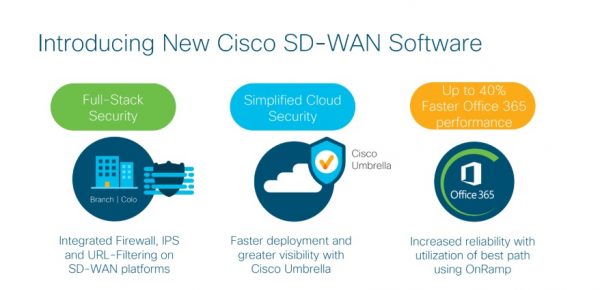LAS VEGAS – With nearly 50 per cent of customers planning to deploy software-defined wide-area networks (SD-WAN) in the next 12 months, Cisco Systems is hoping its latest announcement to unite its SD-WAN technologies with its security portfolio will make that process a little easier.
At its partner summit event, the networking vendor announced that it’s putting its enterprise firewall, URL filtering and intrusion prevention systems directly into its integrated service routers through a software update. Those routers will also be able to connect to Cisco’s Umbrella cloud security offering, which blocks access to malicious destinations before a connection is ever established.
It’s an important move, one that lays the groundwork for a future where enterprise applications are moving to the cloud, says Steven Schuchart, principal enterprise networking analyst with Global Data.
“One thing I can say that isn’t Cisco marketing hyperbole is that security cannot be a separate thing. It needs to be one of the initial considerations for bringing the network up,” he says.
Until now, organizations first had to figure out bandwidth and connectivity requirements in addition to various other business-related calculations.
“And then you would go, ‘okay, now how do we secure it?’” explains Schuchart.

Infographic courtesy Cisco.
The SD-WAN infrastructure market could be worth more than $4.5 billion by 2022, according to IDC, but what’s preventing a lot of partners and customers from diving head first into the market is the fact that their critical data is passing through the internet, making it an easy target for hackers.
In order to bolster their network security, organizations often partner with a separate security business to layer on those capabilities.
This separation of security and application experience has resulted in a fragmented SD-WAN market, says Brent Allison, CEO of Long View Systems.
“We find it a little frustrating and we’re looking for leadership from Cisco in this space,” he told CDN. “We’ve been working with a few partners on some proof of concepts, but there’s no question the SD-WAN market is going to consolidate and scale over time.”
Kent MacDonald, SVP of strategic alliances for Long View, says he was pleased to see Cisco’s ongoing investments in security and its deeper integration with the SD-WAN portfolio.
He describes the move as a “door-opener” to solving most of their customers’ challenges around their networking investments.
Cisco is well-positioned to be a leader in this space because of the company’s security roots, suggests Schuchart.
“They have a wide and deep security portfolio. For a lot of other SD-WAN vendors, their security is through partners. It doesn’t mean they can’t have a deep and meaningful relationship with those partners … it just makes it more complicated for them.”
Integrating security into Cisco’s SD-WAN portfolio allows Cisco’s partners to deliver broader managed services to more customers, who often find the unification of the two an attractive prospect, says Ron Temske, vice-president of security and network solutions for U.S.-based Logicalis, a Cisco partner.
“Customers are looking for help when it comes to managing SD-WAN. We’re seeing a lot of demand for it,” he says.
Cisco has also partnered with Microsoft to improve the Office 365 application experience by determining the closest cloud infrastructure in real-time, resulting in a 40 per cent faster performance for users, explains Scott Harrell, senior vice-president and general manager of enterprise networking for Cisco.
This, he says, combined with the security integration announcement, will simplify a lot for business adopting more cloud-based applications, which requires more use of the WAN to get the performance they need.
SD-WAN demand in Canada healthy
While Canada’s SD-WAN market is still in development, customers are well aware of its potential benefits and are asking for it, says Rupinder Singh, director of systems engineering for Cisco Canada.
“We have a lot of proof of concepts in the works right now,” he says, and as more Canadian partners become well-versed in SD-WAN, they will be the ones delivering that technology to customers.
Canada is also well positioned from a connectivity standpoint, says Allison, but it’s behind when it comes to innovation.
“When we talk to our Canadian customers, they will often say, ‘give me that tried and true thing that’s been tested 10 times. When we talk to U.S. customers, they say ‘give me that thing that’s cutting edge that will get me promoted.’ They’re very different conversations.”





